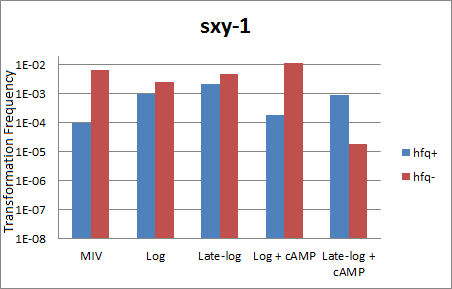Well, here some of the results:
In KW20, we can notice a roughly 10-fold reduction in the TF for Δhfq in
MIV medium. The disparity also appears to increase with the density of
the culture since we see little to no reduction in TF for the log phase cells (OD600 = 0.2) but almost an 100-fold decrease for late-log conditions (OD600 = 1.0). Perhaps whatever causes an increase in TF as the cells get dense fails to function normally in Δhfq?
In murE749, there appears to be no difference in TF under MIV conditions. There is a clear difference under log and late-log conditions though. It's interesting to see cAMP restore TF under log conditions and slightly restore it under late-log.
- the TF is much lower than expected for sxy-1 under MIV and log + cAMP conditions and higher than what is expected for log phase (expect around 5 × 10 to the -5)
- the growth rate is for sxy-1 is as slow, if not slower than it is for Δhfq (which we would expect it to be faster)
Here, we can see that it almost appears that the Δhfq double mutant is slightly more competent than sxy-1 alone. Of course, the difference is small enough that it is likely just measurement error but what should be noted is that there is no obvious transformation defect in the Δhfq strain here (except what maybe in late-log + cAMP) and in fact, the log phase results seem really high compared to what is expected (expect around 5 × 10 to the -5). I would like to redo these two conditions to be sure that these are accurate values.
So from here, I will first try to get accurate sxy-1 values by using a different strain with the sxy-1 mutation. Next I would like to look at sxy-2 (another hypercompetence mutant) and sxy-7 (a strain with little to no actual transformation) under these conditions.




Excellent research blogging!
ReplyDelete